AYR Co. Project Appraisal: Strategic Financial Management Report
VerifiedAdded on 2022/11/14
|17
|4182
|347
Report
AI Summary
This report provides a comprehensive analysis of two projects, Aspire and Wolf, for AYR Co. The analysis includes detailed calculations of Net Present Value (NPV), Internal Rate of Return (IRR), and Payback Period for each project. Based on these investment appraisal techniques, the report recommends Project Wolf as the more viable option due to its higher NPV, lower payback period, and higher IRR. The report justifies this recommendation by comparing the financial metrics of both projects. Additionally, it identifies other critical factors to consider, such as staff motivation, customer satisfaction, and competitor actions, before making a final investment decision. Furthermore, the report discusses equity and debt as sources of finance, explaining their costs and analyzing their impact on AYR Co.'s Weighted Average Cost of Capital (WACC) and stakeholders. The report concludes with a summary of findings and recommendations.
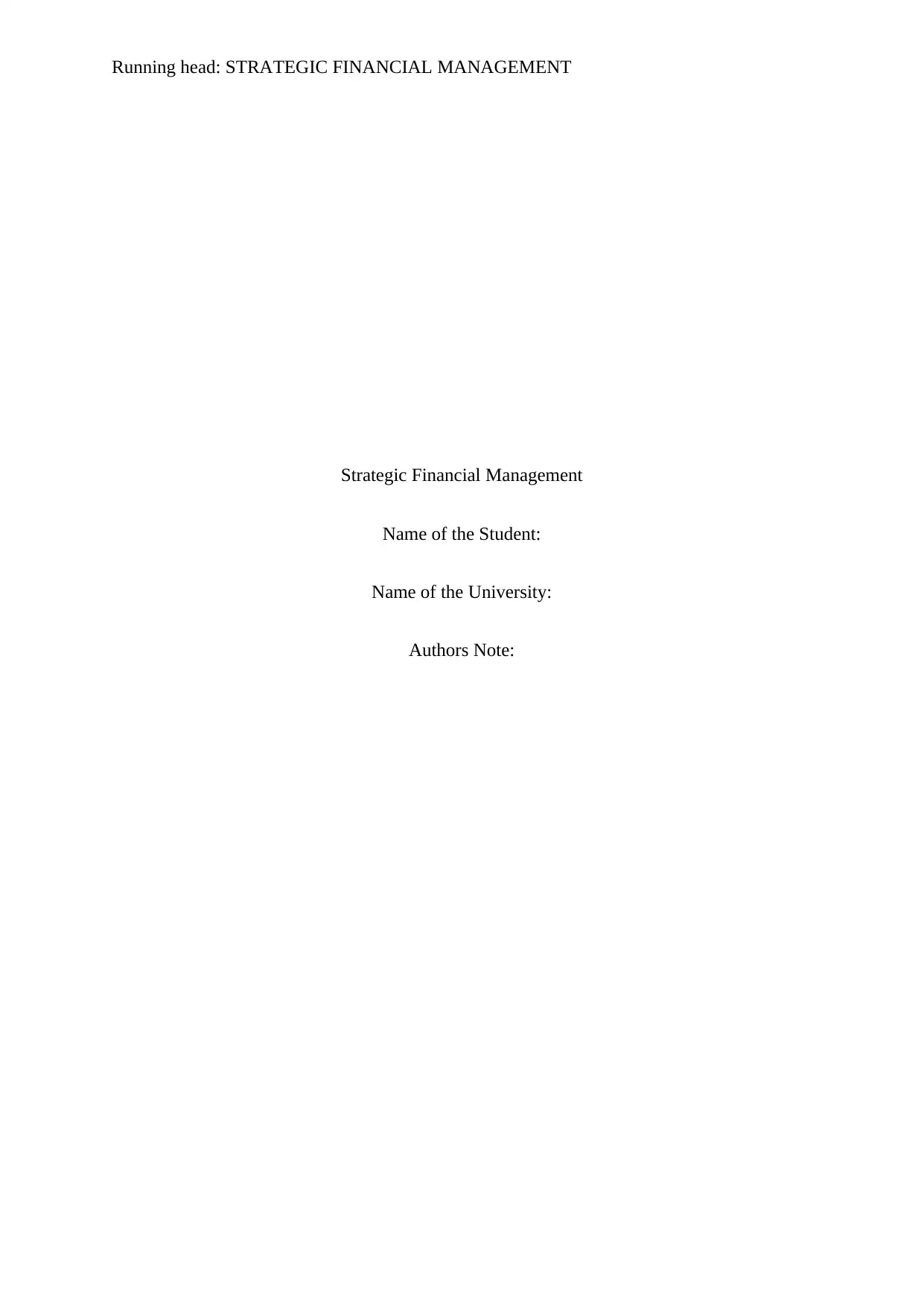
Running head: STRATEGIC FINANCIAL MANAGEMENT
Strategic Financial Management
Name of the Student:
Name of the University:
Authors Note:
Strategic Financial Management
Name of the Student:
Name of the University:
Authors Note:
Paraphrase This Document
Need a fresh take? Get an instant paraphrase of this document with our AI Paraphraser
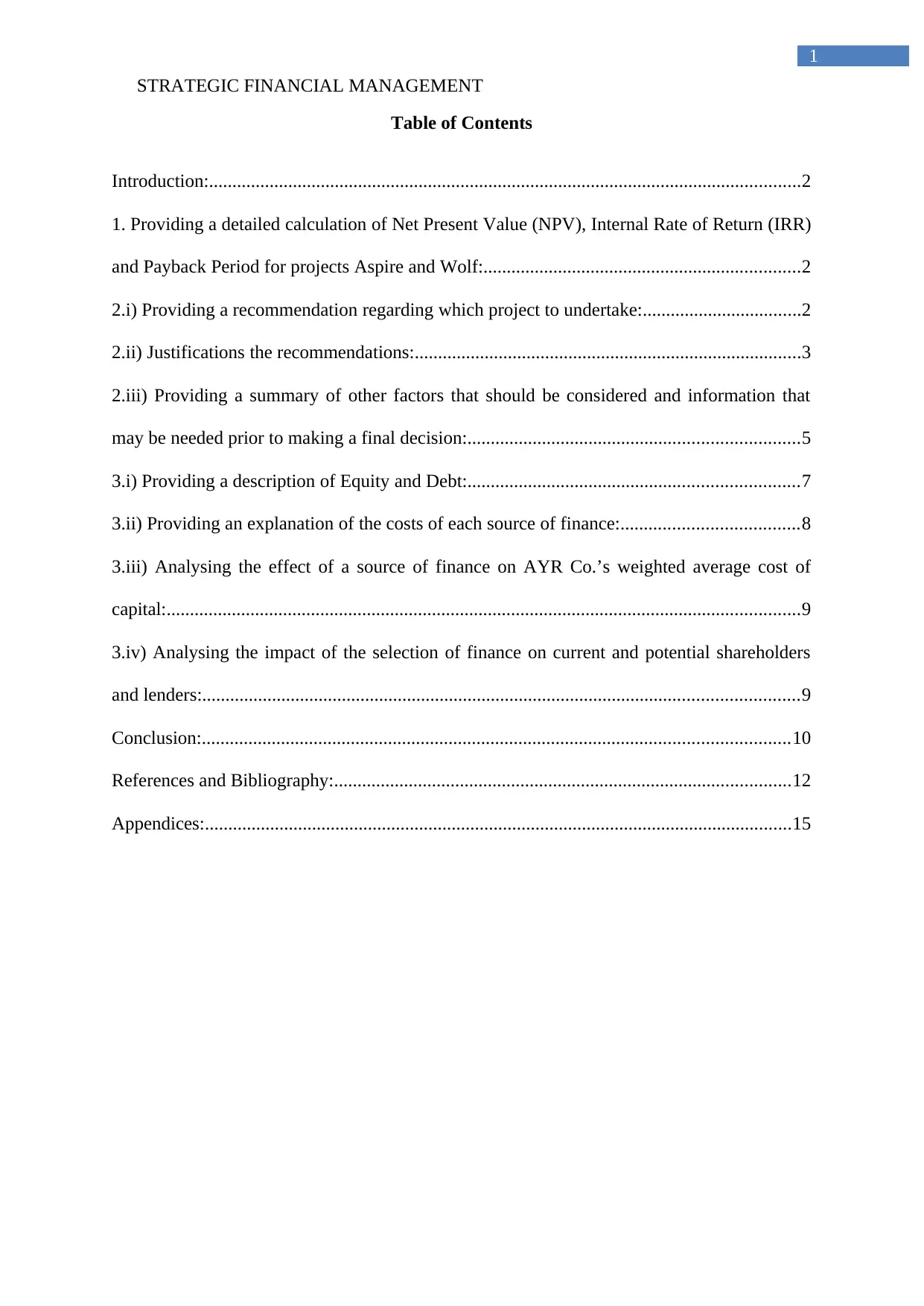
STRATEGIC FINANCIAL MANAGEMENT
1
Table of Contents
Introduction:...............................................................................................................................2
1. Providing a detailed calculation of Net Present Value (NPV), Internal Rate of Return (IRR)
and Payback Period for projects Aspire and Wolf:....................................................................2
2.i) Providing a recommendation regarding which project to undertake:..................................2
2.ii) Justifications the recommendations:...................................................................................3
2.iii) Providing a summary of other factors that should be considered and information that
may be needed prior to making a final decision:.......................................................................5
3.i) Providing a description of Equity and Debt:.......................................................................7
3.ii) Providing an explanation of the costs of each source of finance:......................................8
3.iii) Analysing the effect of a source of finance on AYR Co.’s weighted average cost of
capital:........................................................................................................................................9
3.iv) Analysing the impact of the selection of finance on current and potential shareholders
and lenders:................................................................................................................................9
Conclusion:..............................................................................................................................10
References and Bibliography:..................................................................................................12
Appendices:..............................................................................................................................15
1
Table of Contents
Introduction:...............................................................................................................................2
1. Providing a detailed calculation of Net Present Value (NPV), Internal Rate of Return (IRR)
and Payback Period for projects Aspire and Wolf:....................................................................2
2.i) Providing a recommendation regarding which project to undertake:..................................2
2.ii) Justifications the recommendations:...................................................................................3
2.iii) Providing a summary of other factors that should be considered and information that
may be needed prior to making a final decision:.......................................................................5
3.i) Providing a description of Equity and Debt:.......................................................................7
3.ii) Providing an explanation of the costs of each source of finance:......................................8
3.iii) Analysing the effect of a source of finance on AYR Co.’s weighted average cost of
capital:........................................................................................................................................9
3.iv) Analysing the impact of the selection of finance on current and potential shareholders
and lenders:................................................................................................................................9
Conclusion:..............................................................................................................................10
References and Bibliography:..................................................................................................12
Appendices:..............................................................................................................................15
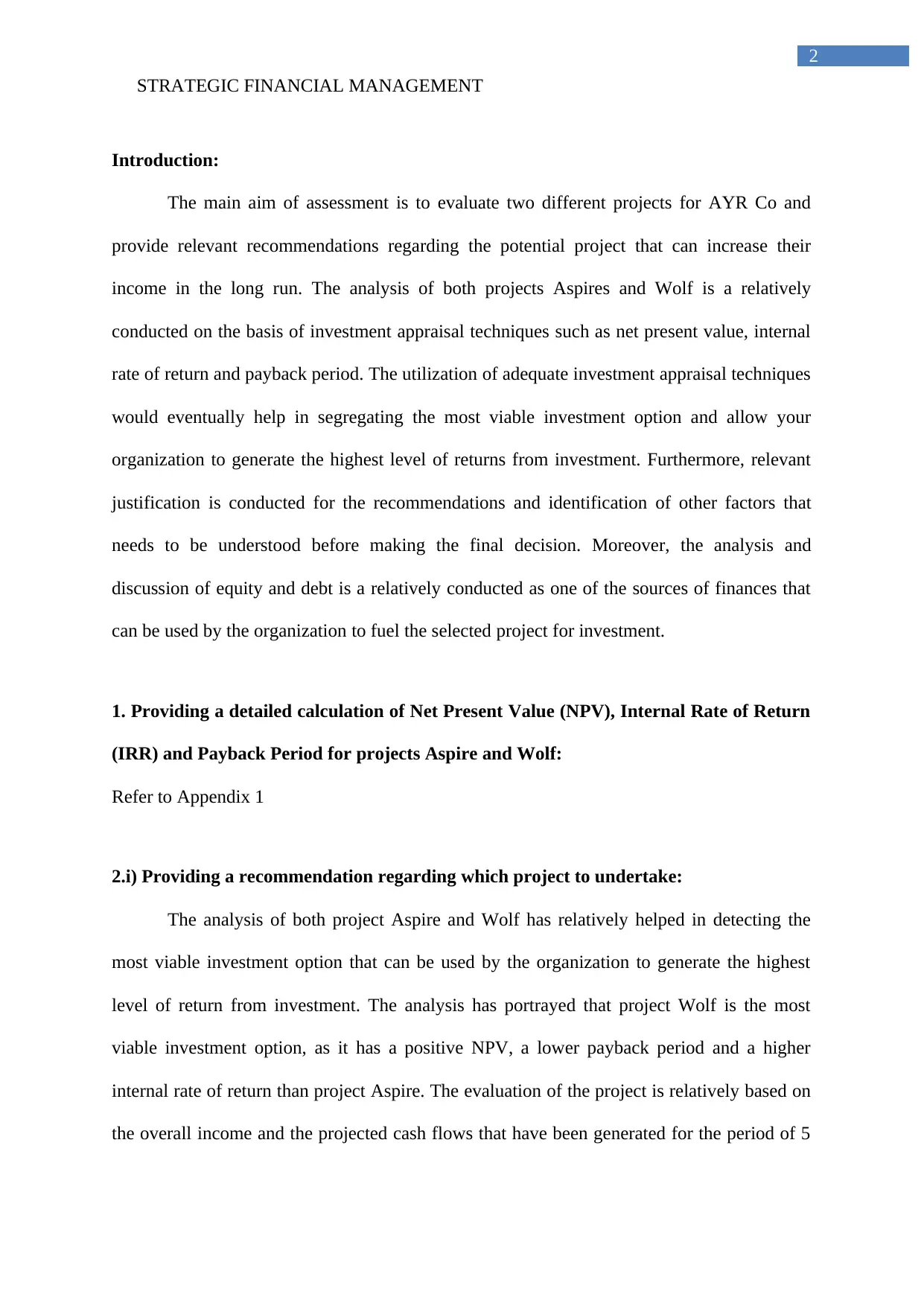
STRATEGIC FINANCIAL MANAGEMENT
2
Introduction:
The main aim of assessment is to evaluate two different projects for AYR Co and
provide relevant recommendations regarding the potential project that can increase their
income in the long run. The analysis of both projects Aspires and Wolf is a relatively
conducted on the basis of investment appraisal techniques such as net present value, internal
rate of return and payback period. The utilization of adequate investment appraisal techniques
would eventually help in segregating the most viable investment option and allow your
organization to generate the highest level of returns from investment. Furthermore, relevant
justification is conducted for the recommendations and identification of other factors that
needs to be understood before making the final decision. Moreover, the analysis and
discussion of equity and debt is a relatively conducted as one of the sources of finances that
can be used by the organization to fuel the selected project for investment.
1. Providing a detailed calculation of Net Present Value (NPV), Internal Rate of Return
(IRR) and Payback Period for projects Aspire and Wolf:
Refer to Appendix 1
2.i) Providing a recommendation regarding which project to undertake:
The analysis of both project Aspire and Wolf has relatively helped in detecting the
most viable investment option that can be used by the organization to generate the highest
level of return from investment. The analysis has portrayed that project Wolf is the most
viable investment option, as it has a positive NPV, a lower payback period and a higher
internal rate of return than project Aspire. The evaluation of the project is relatively based on
the overall income and the projected cash flows that have been generated for the period of 5
2
Introduction:
The main aim of assessment is to evaluate two different projects for AYR Co and
provide relevant recommendations regarding the potential project that can increase their
income in the long run. The analysis of both projects Aspires and Wolf is a relatively
conducted on the basis of investment appraisal techniques such as net present value, internal
rate of return and payback period. The utilization of adequate investment appraisal techniques
would eventually help in segregating the most viable investment option and allow your
organization to generate the highest level of returns from investment. Furthermore, relevant
justification is conducted for the recommendations and identification of other factors that
needs to be understood before making the final decision. Moreover, the analysis and
discussion of equity and debt is a relatively conducted as one of the sources of finances that
can be used by the organization to fuel the selected project for investment.
1. Providing a detailed calculation of Net Present Value (NPV), Internal Rate of Return
(IRR) and Payback Period for projects Aspire and Wolf:
Refer to Appendix 1
2.i) Providing a recommendation regarding which project to undertake:
The analysis of both project Aspire and Wolf has relatively helped in detecting the
most viable investment option that can be used by the organization to generate the highest
level of return from investment. The analysis has portrayed that project Wolf is the most
viable investment option, as it has a positive NPV, a lower payback period and a higher
internal rate of return than project Aspire. The evaluation of the project is relatively based on
the overall income and the projected cash flows that have been generated for the period of 5
⊘ This is a preview!⊘
Do you want full access?
Subscribe today to unlock all pages.

Trusted by 1+ million students worldwide
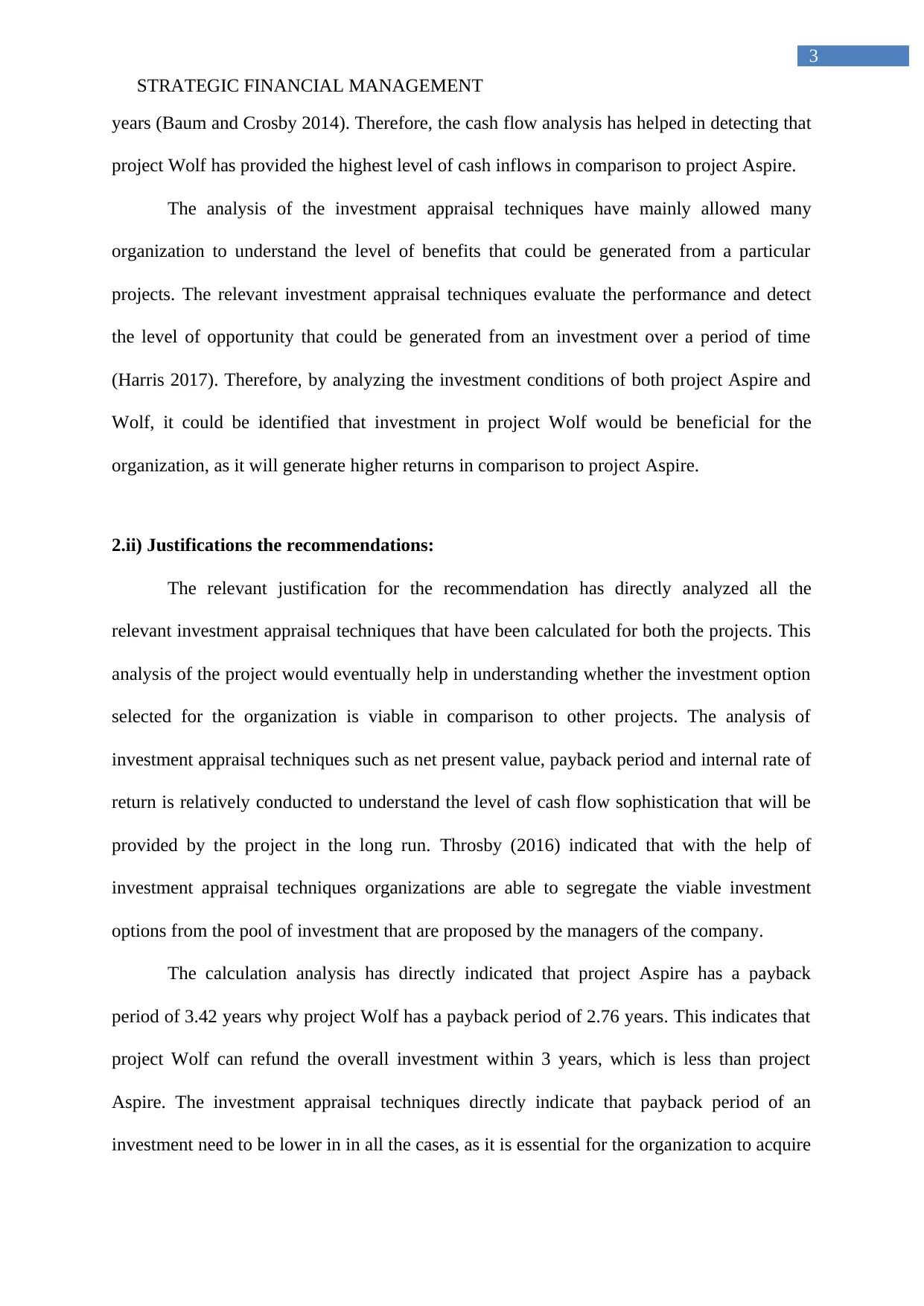
STRATEGIC FINANCIAL MANAGEMENT
3
years (Baum and Crosby 2014). Therefore, the cash flow analysis has helped in detecting that
project Wolf has provided the highest level of cash inflows in comparison to project Aspire.
The analysis of the investment appraisal techniques have mainly allowed many
organization to understand the level of benefits that could be generated from a particular
projects. The relevant investment appraisal techniques evaluate the performance and detect
the level of opportunity that could be generated from an investment over a period of time
(Harris 2017). Therefore, by analyzing the investment conditions of both project Aspire and
Wolf, it could be identified that investment in project Wolf would be beneficial for the
organization, as it will generate higher returns in comparison to project Aspire.
2.ii) Justifications the recommendations:
The relevant justification for the recommendation has directly analyzed all the
relevant investment appraisal techniques that have been calculated for both the projects. This
analysis of the project would eventually help in understanding whether the investment option
selected for the organization is viable in comparison to other projects. The analysis of
investment appraisal techniques such as net present value, payback period and internal rate of
return is relatively conducted to understand the level of cash flow sophistication that will be
provided by the project in the long run. Throsby (2016) indicated that with the help of
investment appraisal techniques organizations are able to segregate the viable investment
options from the pool of investment that are proposed by the managers of the company.
The calculation analysis has directly indicated that project Aspire has a payback
period of 3.42 years why project Wolf has a payback period of 2.76 years. This indicates that
project Wolf can refund the overall investment within 3 years, which is less than project
Aspire. The investment appraisal techniques directly indicate that payback period of an
investment need to be lower in in all the cases, as it is essential for the organization to acquire
3
years (Baum and Crosby 2014). Therefore, the cash flow analysis has helped in detecting that
project Wolf has provided the highest level of cash inflows in comparison to project Aspire.
The analysis of the investment appraisal techniques have mainly allowed many
organization to understand the level of benefits that could be generated from a particular
projects. The relevant investment appraisal techniques evaluate the performance and detect
the level of opportunity that could be generated from an investment over a period of time
(Harris 2017). Therefore, by analyzing the investment conditions of both project Aspire and
Wolf, it could be identified that investment in project Wolf would be beneficial for the
organization, as it will generate higher returns in comparison to project Aspire.
2.ii) Justifications the recommendations:
The relevant justification for the recommendation has directly analyzed all the
relevant investment appraisal techniques that have been calculated for both the projects. This
analysis of the project would eventually help in understanding whether the investment option
selected for the organization is viable in comparison to other projects. The analysis of
investment appraisal techniques such as net present value, payback period and internal rate of
return is relatively conducted to understand the level of cash flow sophistication that will be
provided by the project in the long run. Throsby (2016) indicated that with the help of
investment appraisal techniques organizations are able to segregate the viable investment
options from the pool of investment that are proposed by the managers of the company.
The calculation analysis has directly indicated that project Aspire has a payback
period of 3.42 years why project Wolf has a payback period of 2.76 years. This indicates that
project Wolf can refund the overall investment within 3 years, which is less than project
Aspire. The investment appraisal techniques directly indicate that payback period of an
investment need to be lower in in all the cases, as it is essential for the organization to acquire
Paraphrase This Document
Need a fresh take? Get an instant paraphrase of this document with our AI Paraphraser
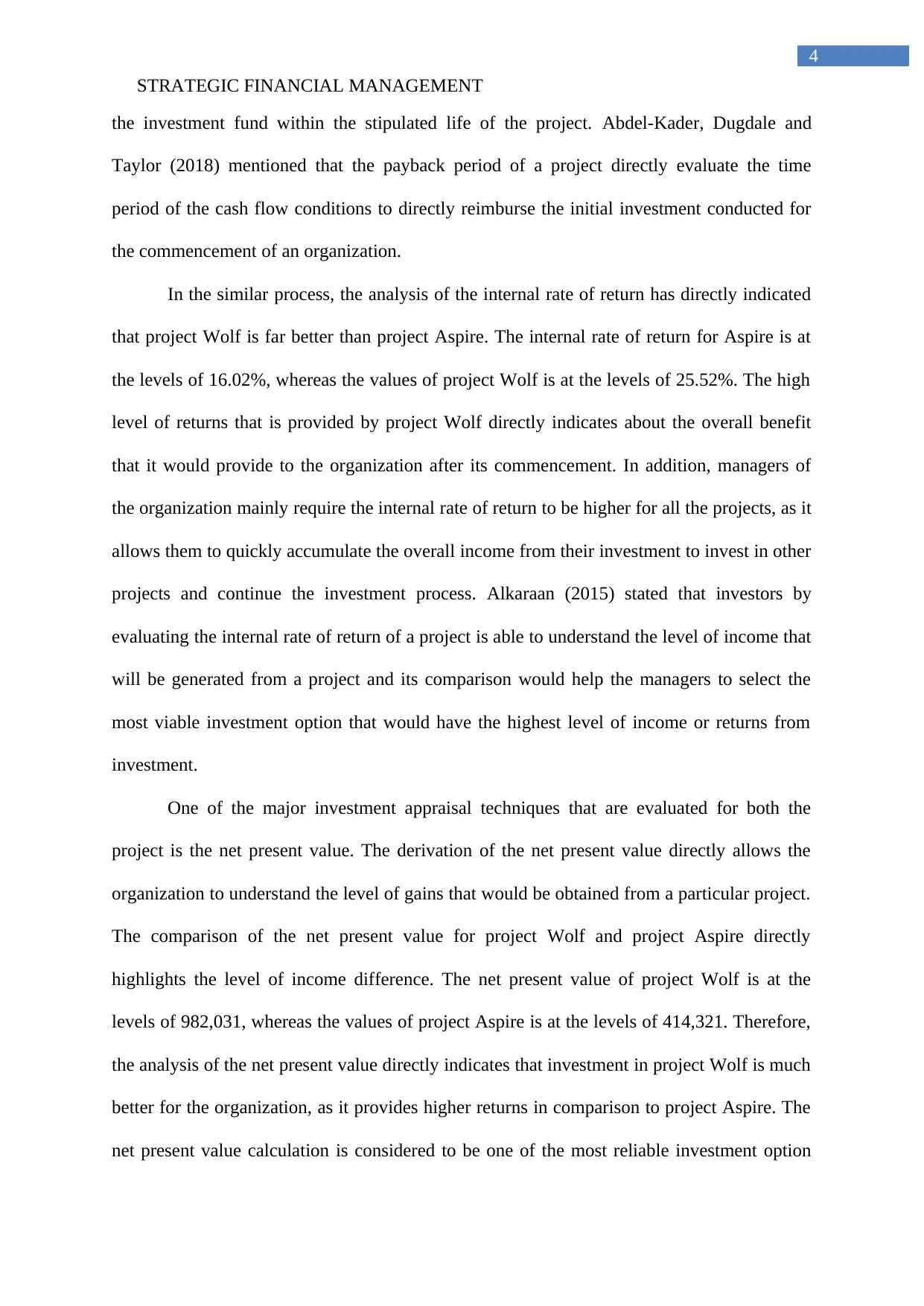
STRATEGIC FINANCIAL MANAGEMENT
4
the investment fund within the stipulated life of the project. Abdel-Kader, Dugdale and
Taylor (2018) mentioned that the payback period of a project directly evaluate the time
period of the cash flow conditions to directly reimburse the initial investment conducted for
the commencement of an organization.
In the similar process, the analysis of the internal rate of return has directly indicated
that project Wolf is far better than project Aspire. The internal rate of return for Aspire is at
the levels of 16.02%, whereas the values of project Wolf is at the levels of 25.52%. The high
level of returns that is provided by project Wolf directly indicates about the overall benefit
that it would provide to the organization after its commencement. In addition, managers of
the organization mainly require the internal rate of return to be higher for all the projects, as it
allows them to quickly accumulate the overall income from their investment to invest in other
projects and continue the investment process. Alkaraan (2015) stated that investors by
evaluating the internal rate of return of a project is able to understand the level of income that
will be generated from a project and its comparison would help the managers to select the
most viable investment option that would have the highest level of income or returns from
investment.
One of the major investment appraisal techniques that are evaluated for both the
project is the net present value. The derivation of the net present value directly allows the
organization to understand the level of gains that would be obtained from a particular project.
The comparison of the net present value for project Wolf and project Aspire directly
highlights the level of income difference. The net present value of project Wolf is at the
levels of 982,031, whereas the values of project Aspire is at the levels of 414,321. Therefore,
the analysis of the net present value directly indicates that investment in project Wolf is much
better for the organization, as it provides higher returns in comparison to project Aspire. The
net present value calculation is considered to be one of the most reliable investment option
4
the investment fund within the stipulated life of the project. Abdel-Kader, Dugdale and
Taylor (2018) mentioned that the payback period of a project directly evaluate the time
period of the cash flow conditions to directly reimburse the initial investment conducted for
the commencement of an organization.
In the similar process, the analysis of the internal rate of return has directly indicated
that project Wolf is far better than project Aspire. The internal rate of return for Aspire is at
the levels of 16.02%, whereas the values of project Wolf is at the levels of 25.52%. The high
level of returns that is provided by project Wolf directly indicates about the overall benefit
that it would provide to the organization after its commencement. In addition, managers of
the organization mainly require the internal rate of return to be higher for all the projects, as it
allows them to quickly accumulate the overall income from their investment to invest in other
projects and continue the investment process. Alkaraan (2015) stated that investors by
evaluating the internal rate of return of a project is able to understand the level of income that
will be generated from a project and its comparison would help the managers to select the
most viable investment option that would have the highest level of income or returns from
investment.
One of the major investment appraisal techniques that are evaluated for both the
project is the net present value. The derivation of the net present value directly allows the
organization to understand the level of gains that would be obtained from a particular project.
The comparison of the net present value for project Wolf and project Aspire directly
highlights the level of income difference. The net present value of project Wolf is at the
levels of 982,031, whereas the values of project Aspire is at the levels of 414,321. Therefore,
the analysis of the net present value directly indicates that investment in project Wolf is much
better for the organization, as it provides higher returns in comparison to project Aspire. The
net present value calculation is considered to be one of the most reliable investment option
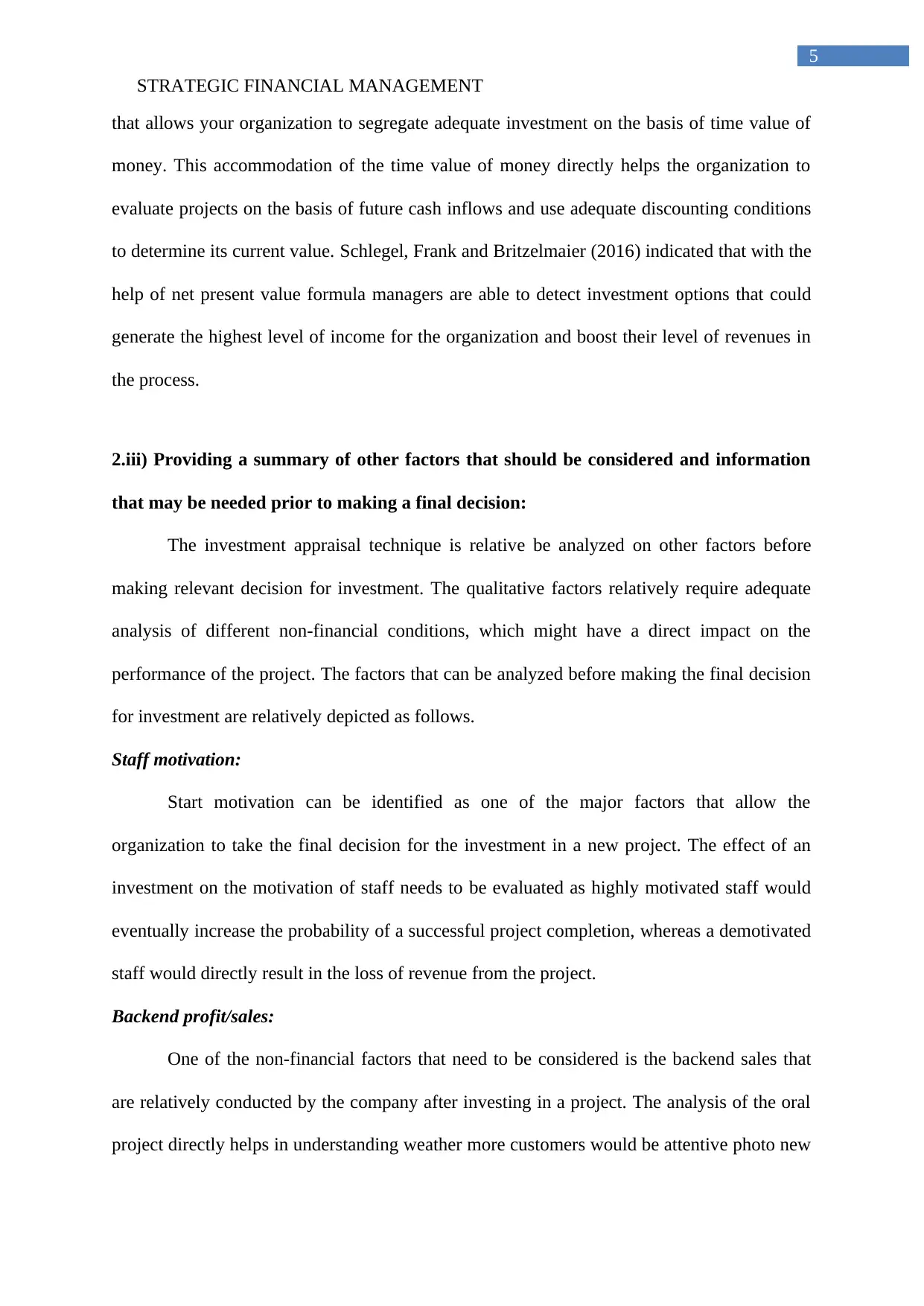
STRATEGIC FINANCIAL MANAGEMENT
5
that allows your organization to segregate adequate investment on the basis of time value of
money. This accommodation of the time value of money directly helps the organization to
evaluate projects on the basis of future cash inflows and use adequate discounting conditions
to determine its current value. Schlegel, Frank and Britzelmaier (2016) indicated that with the
help of net present value formula managers are able to detect investment options that could
generate the highest level of income for the organization and boost their level of revenues in
the process.
2.iii) Providing a summary of other factors that should be considered and information
that may be needed prior to making a final decision:
The investment appraisal technique is relative be analyzed on other factors before
making relevant decision for investment. The qualitative factors relatively require adequate
analysis of different non-financial conditions, which might have a direct impact on the
performance of the project. The factors that can be analyzed before making the final decision
for investment are relatively depicted as follows.
Staff motivation:
Start motivation can be identified as one of the major factors that allow the
organization to take the final decision for the investment in a new project. The effect of an
investment on the motivation of staff needs to be evaluated as highly motivated staff would
eventually increase the probability of a successful project completion, whereas a demotivated
staff would directly result in the loss of revenue from the project.
Backend profit/sales:
One of the non-financial factors that need to be considered is the backend sales that
are relatively conducted by the company after investing in a project. The analysis of the oral
project directly helps in understanding weather more customers would be attentive photo new
5
that allows your organization to segregate adequate investment on the basis of time value of
money. This accommodation of the time value of money directly helps the organization to
evaluate projects on the basis of future cash inflows and use adequate discounting conditions
to determine its current value. Schlegel, Frank and Britzelmaier (2016) indicated that with the
help of net present value formula managers are able to detect investment options that could
generate the highest level of income for the organization and boost their level of revenues in
the process.
2.iii) Providing a summary of other factors that should be considered and information
that may be needed prior to making a final decision:
The investment appraisal technique is relative be analyzed on other factors before
making relevant decision for investment. The qualitative factors relatively require adequate
analysis of different non-financial conditions, which might have a direct impact on the
performance of the project. The factors that can be analyzed before making the final decision
for investment are relatively depicted as follows.
Staff motivation:
Start motivation can be identified as one of the major factors that allow the
organization to take the final decision for the investment in a new project. The effect of an
investment on the motivation of staff needs to be evaluated as highly motivated staff would
eventually increase the probability of a successful project completion, whereas a demotivated
staff would directly result in the loss of revenue from the project.
Backend profit/sales:
One of the non-financial factors that need to be considered is the backend sales that
are relatively conducted by the company after investing in a project. The analysis of the oral
project directly helps in understanding weather more customers would be attentive photo new
⊘ This is a preview!⊘
Do you want full access?
Subscribe today to unlock all pages.

Trusted by 1+ million students worldwide
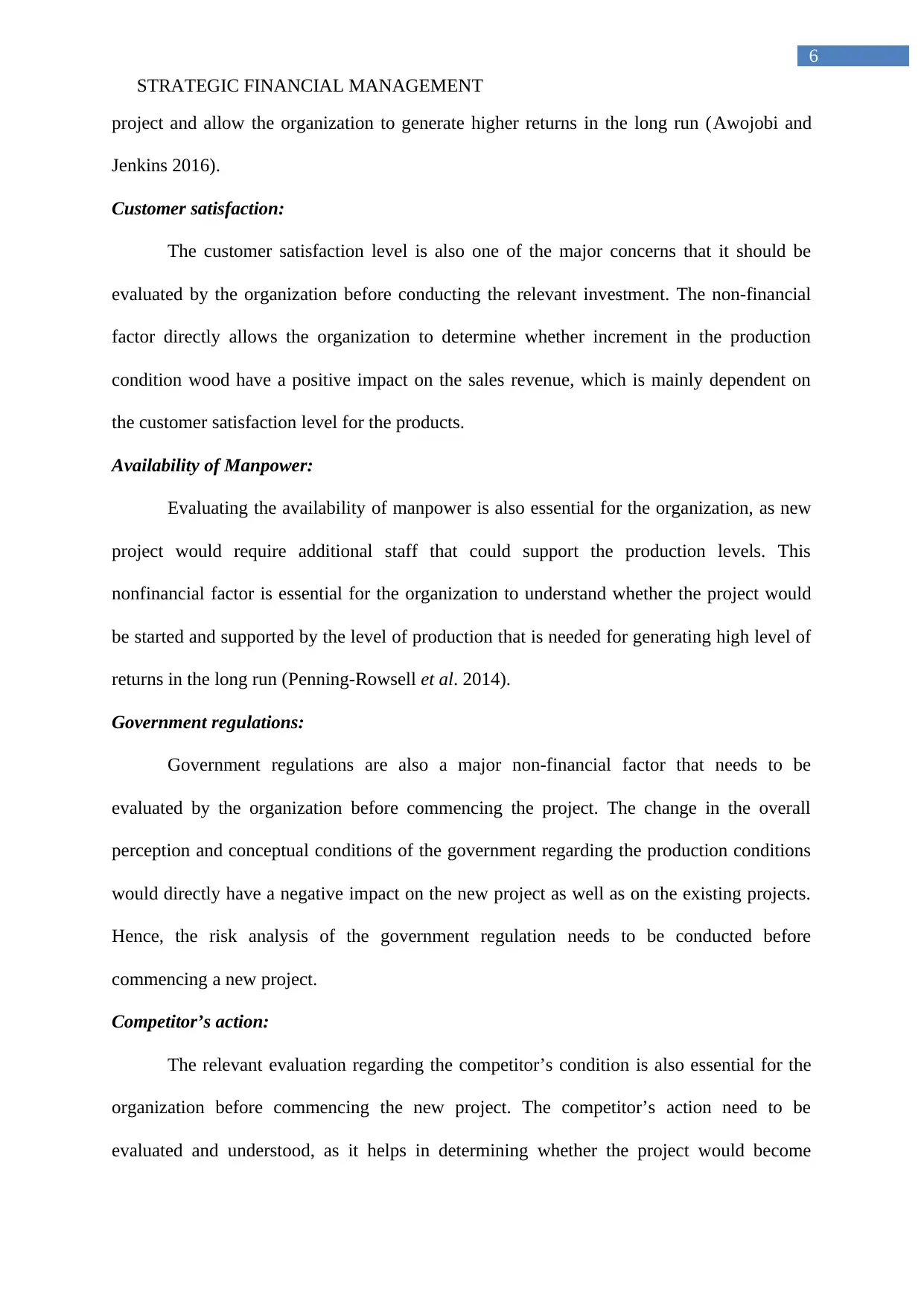
STRATEGIC FINANCIAL MANAGEMENT
6
project and allow the organization to generate higher returns in the long run (Awojobi and
Jenkins 2016).
Customer satisfaction:
The customer satisfaction level is also one of the major concerns that it should be
evaluated by the organization before conducting the relevant investment. The non-financial
factor directly allows the organization to determine whether increment in the production
condition wood have a positive impact on the sales revenue, which is mainly dependent on
the customer satisfaction level for the products.
Availability of Manpower:
Evaluating the availability of manpower is also essential for the organization, as new
project would require additional staff that could support the production levels. This
nonfinancial factor is essential for the organization to understand whether the project would
be started and supported by the level of production that is needed for generating high level of
returns in the long run (Penning-Rowsell et al. 2014).
Government regulations:
Government regulations are also a major non-financial factor that needs to be
evaluated by the organization before commencing the project. The change in the overall
perception and conceptual conditions of the government regarding the production conditions
would directly have a negative impact on the new project as well as on the existing projects.
Hence, the risk analysis of the government regulation needs to be conducted before
commencing a new project.
Competitor’s action:
The relevant evaluation regarding the competitor’s condition is also essential for the
organization before commencing the new project. The competitor’s action need to be
evaluated and understood, as it helps in determining whether the project would become
6
project and allow the organization to generate higher returns in the long run (Awojobi and
Jenkins 2016).
Customer satisfaction:
The customer satisfaction level is also one of the major concerns that it should be
evaluated by the organization before conducting the relevant investment. The non-financial
factor directly allows the organization to determine whether increment in the production
condition wood have a positive impact on the sales revenue, which is mainly dependent on
the customer satisfaction level for the products.
Availability of Manpower:
Evaluating the availability of manpower is also essential for the organization, as new
project would require additional staff that could support the production levels. This
nonfinancial factor is essential for the organization to understand whether the project would
be started and supported by the level of production that is needed for generating high level of
returns in the long run (Penning-Rowsell et al. 2014).
Government regulations:
Government regulations are also a major non-financial factor that needs to be
evaluated by the organization before commencing the project. The change in the overall
perception and conceptual conditions of the government regarding the production conditions
would directly have a negative impact on the new project as well as on the existing projects.
Hence, the risk analysis of the government regulation needs to be conducted before
commencing a new project.
Competitor’s action:
The relevant evaluation regarding the competitor’s condition is also essential for the
organization before commencing the new project. The competitor’s action need to be
evaluated and understood, as it helps in determining whether the project would become
Paraphrase This Document
Need a fresh take? Get an instant paraphrase of this document with our AI Paraphraser
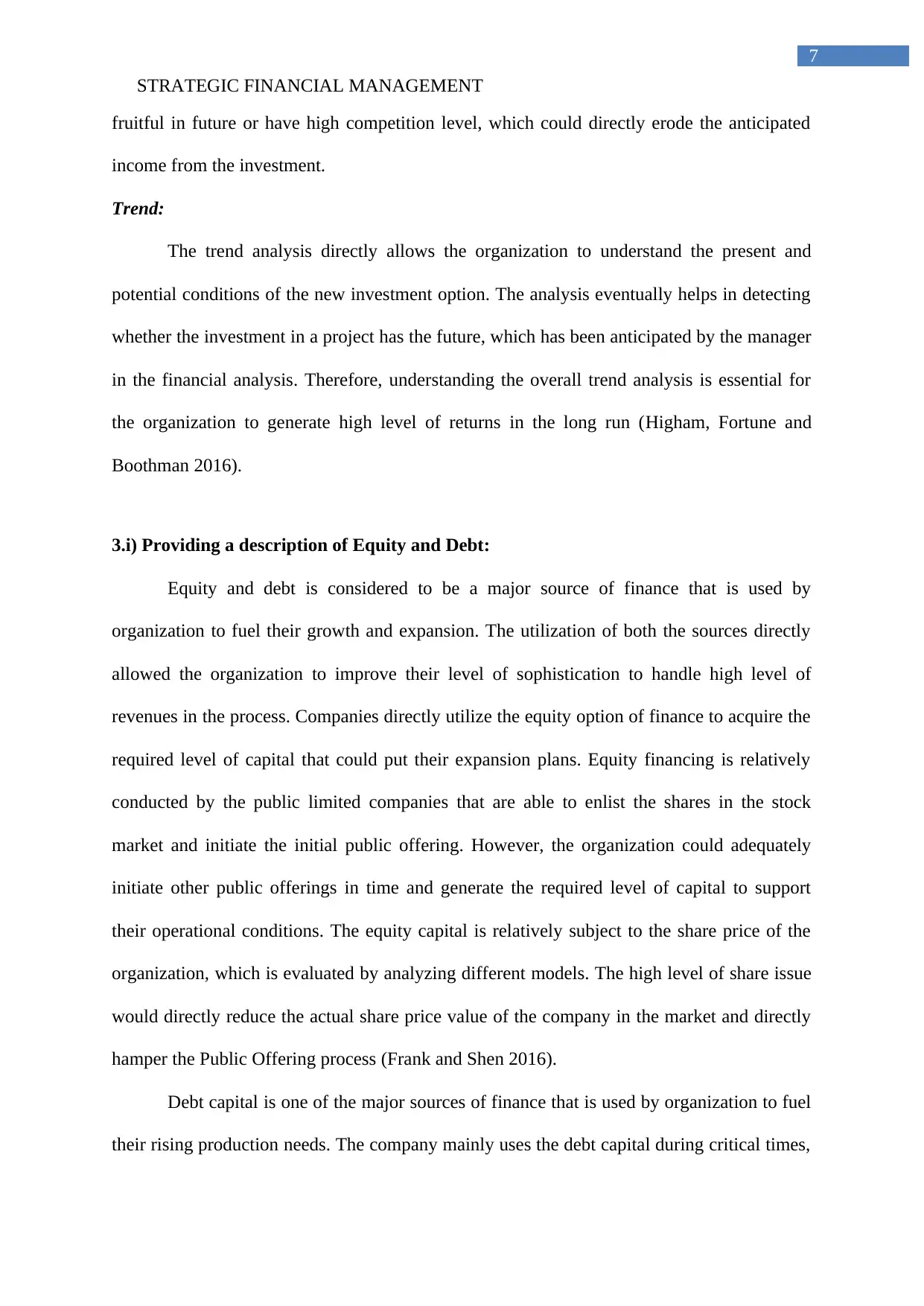
STRATEGIC FINANCIAL MANAGEMENT
7
fruitful in future or have high competition level, which could directly erode the anticipated
income from the investment.
Trend:
The trend analysis directly allows the organization to understand the present and
potential conditions of the new investment option. The analysis eventually helps in detecting
whether the investment in a project has the future, which has been anticipated by the manager
in the financial analysis. Therefore, understanding the overall trend analysis is essential for
the organization to generate high level of returns in the long run (Higham, Fortune and
Boothman 2016).
3.i) Providing a description of Equity and Debt:
Equity and debt is considered to be a major source of finance that is used by
organization to fuel their growth and expansion. The utilization of both the sources directly
allowed the organization to improve their level of sophistication to handle high level of
revenues in the process. Companies directly utilize the equity option of finance to acquire the
required level of capital that could put their expansion plans. Equity financing is relatively
conducted by the public limited companies that are able to enlist the shares in the stock
market and initiate the initial public offering. However, the organization could adequately
initiate other public offerings in time and generate the required level of capital to support
their operational conditions. The equity capital is relatively subject to the share price of the
organization, which is evaluated by analyzing different models. The high level of share issue
would directly reduce the actual share price value of the company in the market and directly
hamper the Public Offering process (Frank and Shen 2016).
Debt capital is one of the major sources of finance that is used by organization to fuel
their rising production needs. The company mainly uses the debt capital during critical times,
7
fruitful in future or have high competition level, which could directly erode the anticipated
income from the investment.
Trend:
The trend analysis directly allows the organization to understand the present and
potential conditions of the new investment option. The analysis eventually helps in detecting
whether the investment in a project has the future, which has been anticipated by the manager
in the financial analysis. Therefore, understanding the overall trend analysis is essential for
the organization to generate high level of returns in the long run (Higham, Fortune and
Boothman 2016).
3.i) Providing a description of Equity and Debt:
Equity and debt is considered to be a major source of finance that is used by
organization to fuel their growth and expansion. The utilization of both the sources directly
allowed the organization to improve their level of sophistication to handle high level of
revenues in the process. Companies directly utilize the equity option of finance to acquire the
required level of capital that could put their expansion plans. Equity financing is relatively
conducted by the public limited companies that are able to enlist the shares in the stock
market and initiate the initial public offering. However, the organization could adequately
initiate other public offerings in time and generate the required level of capital to support
their operational conditions. The equity capital is relatively subject to the share price of the
organization, which is evaluated by analyzing different models. The high level of share issue
would directly reduce the actual share price value of the company in the market and directly
hamper the Public Offering process (Frank and Shen 2016).
Debt capital is one of the major sources of finance that is used by organization to fuel
their rising production needs. The company mainly uses the debt capital during critical times,
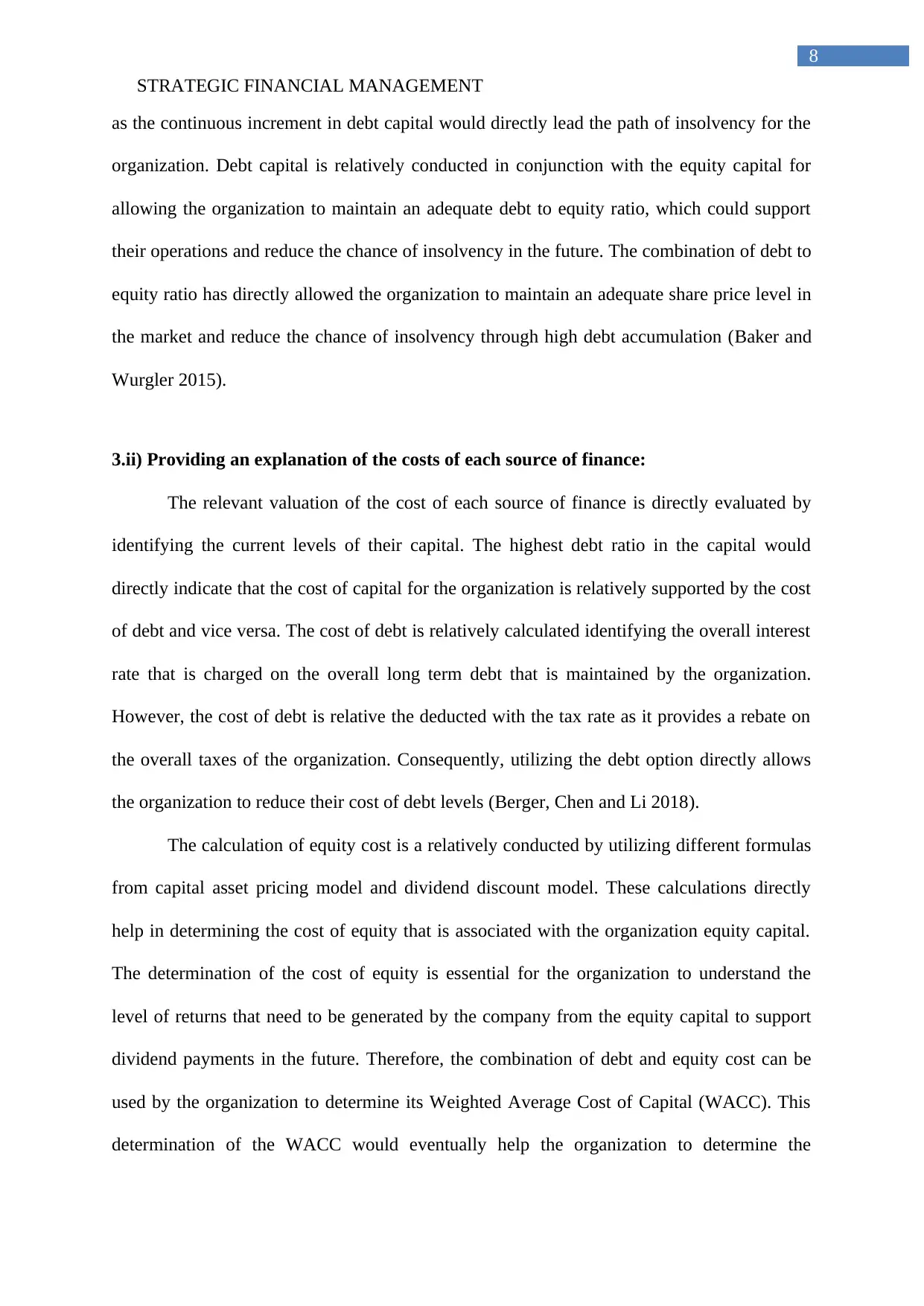
STRATEGIC FINANCIAL MANAGEMENT
8
as the continuous increment in debt capital would directly lead the path of insolvency for the
organization. Debt capital is relatively conducted in conjunction with the equity capital for
allowing the organization to maintain an adequate debt to equity ratio, which could support
their operations and reduce the chance of insolvency in the future. The combination of debt to
equity ratio has directly allowed the organization to maintain an adequate share price level in
the market and reduce the chance of insolvency through high debt accumulation (Baker and
Wurgler 2015).
3.ii) Providing an explanation of the costs of each source of finance:
The relevant valuation of the cost of each source of finance is directly evaluated by
identifying the current levels of their capital. The highest debt ratio in the capital would
directly indicate that the cost of capital for the organization is relatively supported by the cost
of debt and vice versa. The cost of debt is relatively calculated identifying the overall interest
rate that is charged on the overall long term debt that is maintained by the organization.
However, the cost of debt is relative the deducted with the tax rate as it provides a rebate on
the overall taxes of the organization. Consequently, utilizing the debt option directly allows
the organization to reduce their cost of debt levels (Berger, Chen and Li 2018).
The calculation of equity cost is a relatively conducted by utilizing different formulas
from capital asset pricing model and dividend discount model. These calculations directly
help in determining the cost of equity that is associated with the organization equity capital.
The determination of the cost of equity is essential for the organization to understand the
level of returns that need to be generated by the company from the equity capital to support
dividend payments in the future. Therefore, the combination of debt and equity cost can be
used by the organization to determine its Weighted Average Cost of Capital (WACC). This
determination of the WACC would eventually help the organization to determine the
8
as the continuous increment in debt capital would directly lead the path of insolvency for the
organization. Debt capital is relatively conducted in conjunction with the equity capital for
allowing the organization to maintain an adequate debt to equity ratio, which could support
their operations and reduce the chance of insolvency in the future. The combination of debt to
equity ratio has directly allowed the organization to maintain an adequate share price level in
the market and reduce the chance of insolvency through high debt accumulation (Baker and
Wurgler 2015).
3.ii) Providing an explanation of the costs of each source of finance:
The relevant valuation of the cost of each source of finance is directly evaluated by
identifying the current levels of their capital. The highest debt ratio in the capital would
directly indicate that the cost of capital for the organization is relatively supported by the cost
of debt and vice versa. The cost of debt is relatively calculated identifying the overall interest
rate that is charged on the overall long term debt that is maintained by the organization.
However, the cost of debt is relative the deducted with the tax rate as it provides a rebate on
the overall taxes of the organization. Consequently, utilizing the debt option directly allows
the organization to reduce their cost of debt levels (Berger, Chen and Li 2018).
The calculation of equity cost is a relatively conducted by utilizing different formulas
from capital asset pricing model and dividend discount model. These calculations directly
help in determining the cost of equity that is associated with the organization equity capital.
The determination of the cost of equity is essential for the organization to understand the
level of returns that need to be generated by the company from the equity capital to support
dividend payments in the future. Therefore, the combination of debt and equity cost can be
used by the organization to determine its Weighted Average Cost of Capital (WACC). This
determination of the WACC would eventually help the organization to determine the
⊘ This is a preview!⊘
Do you want full access?
Subscribe today to unlock all pages.

Trusted by 1+ million students worldwide
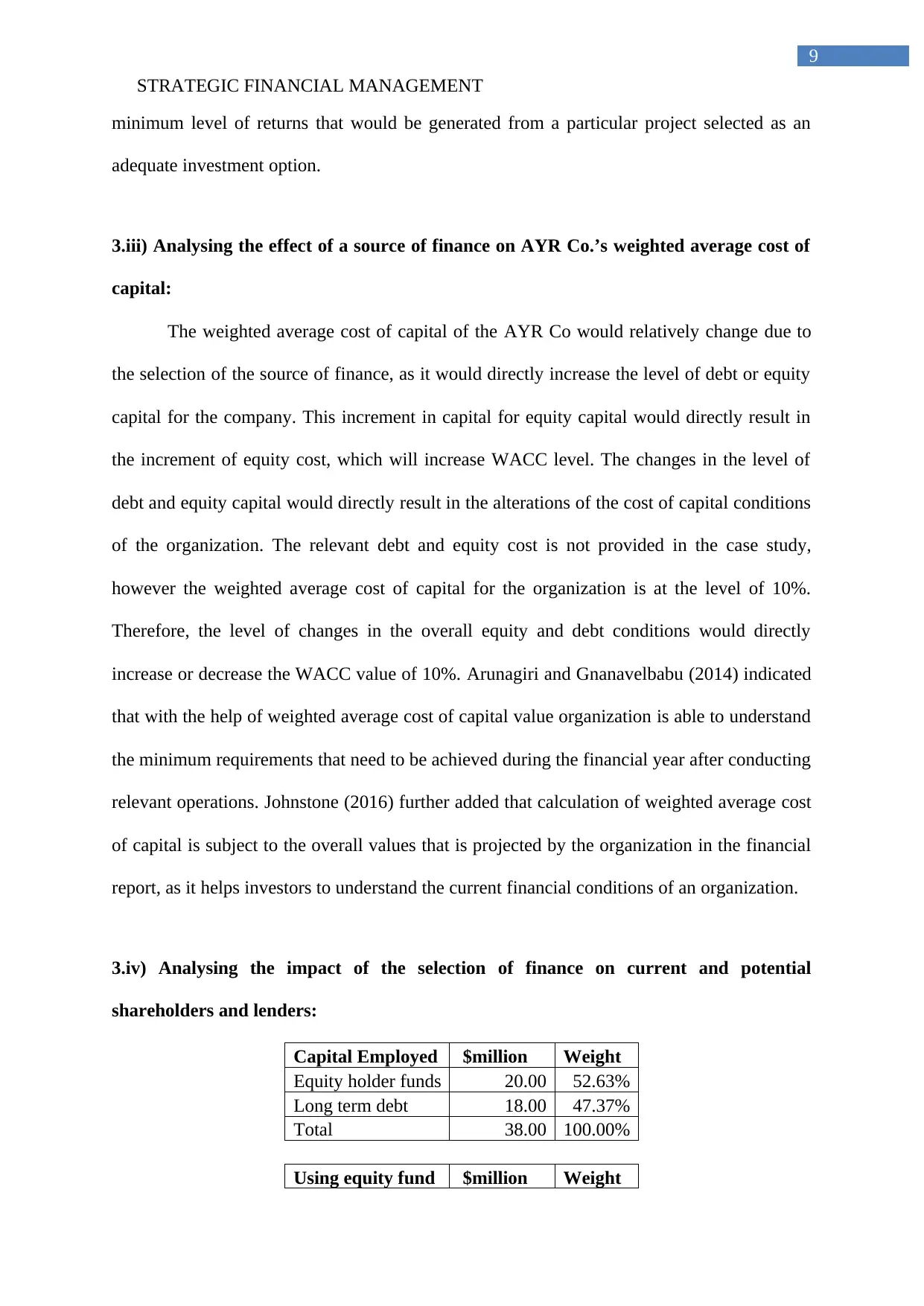
STRATEGIC FINANCIAL MANAGEMENT
9
minimum level of returns that would be generated from a particular project selected as an
adequate investment option.
3.iii) Analysing the effect of a source of finance on AYR Co.’s weighted average cost of
capital:
The weighted average cost of capital of the AYR Co would relatively change due to
the selection of the source of finance, as it would directly increase the level of debt or equity
capital for the company. This increment in capital for equity capital would directly result in
the increment of equity cost, which will increase WACC level. The changes in the level of
debt and equity capital would directly result in the alterations of the cost of capital conditions
of the organization. The relevant debt and equity cost is not provided in the case study,
however the weighted average cost of capital for the organization is at the level of 10%.
Therefore, the level of changes in the overall equity and debt conditions would directly
increase or decrease the WACC value of 10%. Arunagiri and Gnanavelbabu (2014) indicated
that with the help of weighted average cost of capital value organization is able to understand
the minimum requirements that need to be achieved during the financial year after conducting
relevant operations. Johnstone (2016) further added that calculation of weighted average cost
of capital is subject to the overall values that is projected by the organization in the financial
report, as it helps investors to understand the current financial conditions of an organization.
3.iv) Analysing the impact of the selection of finance on current and potential
shareholders and lenders:
Capital Employed $million Weight
Equity holder funds 20.00 52.63%
Long term debt 18.00 47.37%
Total 38.00 100.00%
Using equity fund $million Weight
9
minimum level of returns that would be generated from a particular project selected as an
adequate investment option.
3.iii) Analysing the effect of a source of finance on AYR Co.’s weighted average cost of
capital:
The weighted average cost of capital of the AYR Co would relatively change due to
the selection of the source of finance, as it would directly increase the level of debt or equity
capital for the company. This increment in capital for equity capital would directly result in
the increment of equity cost, which will increase WACC level. The changes in the level of
debt and equity capital would directly result in the alterations of the cost of capital conditions
of the organization. The relevant debt and equity cost is not provided in the case study,
however the weighted average cost of capital for the organization is at the level of 10%.
Therefore, the level of changes in the overall equity and debt conditions would directly
increase or decrease the WACC value of 10%. Arunagiri and Gnanavelbabu (2014) indicated
that with the help of weighted average cost of capital value organization is able to understand
the minimum requirements that need to be achieved during the financial year after conducting
relevant operations. Johnstone (2016) further added that calculation of weighted average cost
of capital is subject to the overall values that is projected by the organization in the financial
report, as it helps investors to understand the current financial conditions of an organization.
3.iv) Analysing the impact of the selection of finance on current and potential
shareholders and lenders:
Capital Employed $million Weight
Equity holder funds 20.00 52.63%
Long term debt 18.00 47.37%
Total 38.00 100.00%
Using equity fund $million Weight
Paraphrase This Document
Need a fresh take? Get an instant paraphrase of this document with our AI Paraphraser
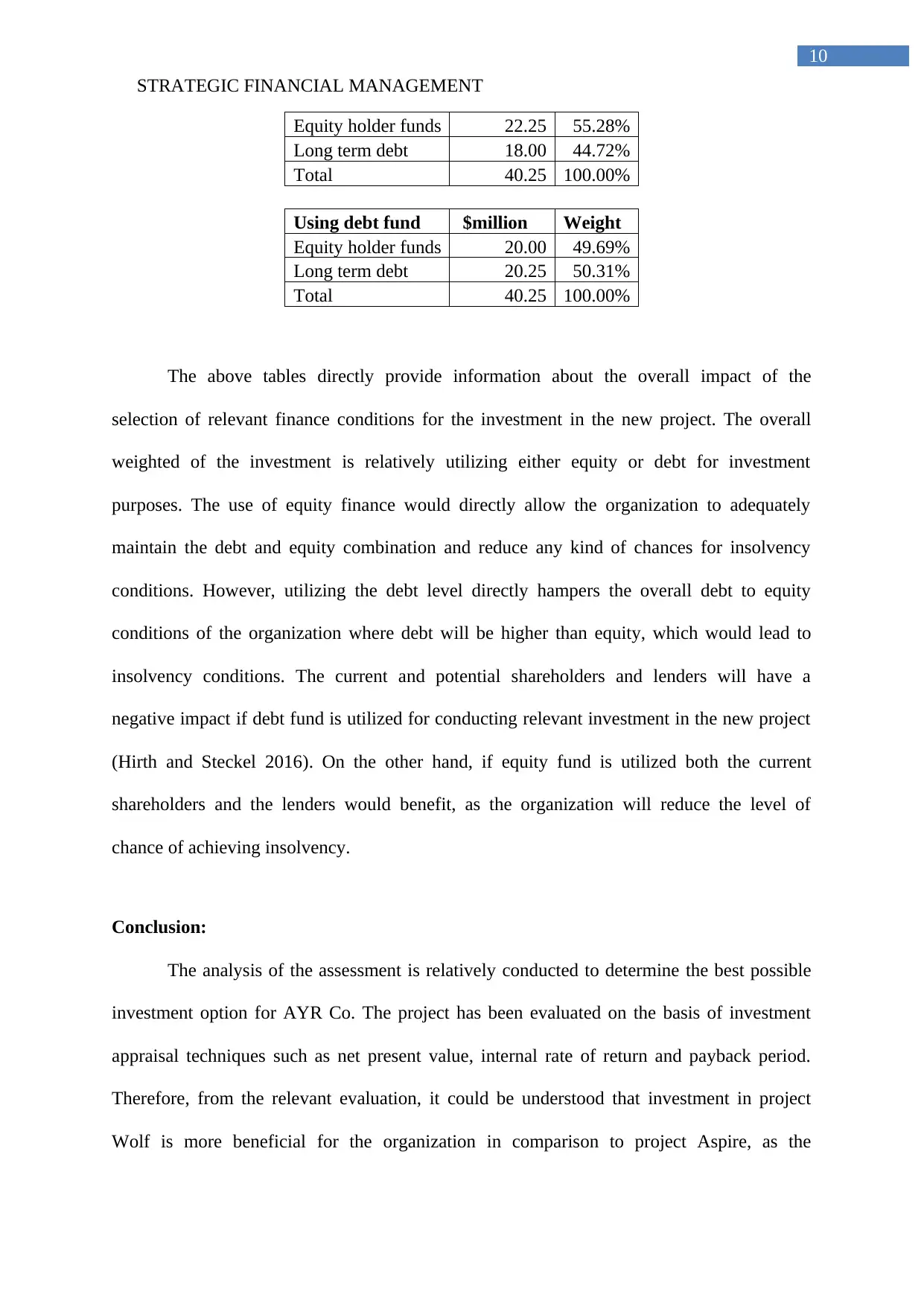
STRATEGIC FINANCIAL MANAGEMENT
10
Equity holder funds 22.25 55.28%
Long term debt 18.00 44.72%
Total 40.25 100.00%
Using debt fund $million Weight
Equity holder funds 20.00 49.69%
Long term debt 20.25 50.31%
Total 40.25 100.00%
The above tables directly provide information about the overall impact of the
selection of relevant finance conditions for the investment in the new project. The overall
weighted of the investment is relatively utilizing either equity or debt for investment
purposes. The use of equity finance would directly allow the organization to adequately
maintain the debt and equity combination and reduce any kind of chances for insolvency
conditions. However, utilizing the debt level directly hampers the overall debt to equity
conditions of the organization where debt will be higher than equity, which would lead to
insolvency conditions. The current and potential shareholders and lenders will have a
negative impact if debt fund is utilized for conducting relevant investment in the new project
(Hirth and Steckel 2016). On the other hand, if equity fund is utilized both the current
shareholders and the lenders would benefit, as the organization will reduce the level of
chance of achieving insolvency.
Conclusion:
The analysis of the assessment is relatively conducted to determine the best possible
investment option for AYR Co. The project has been evaluated on the basis of investment
appraisal techniques such as net present value, internal rate of return and payback period.
Therefore, from the relevant evaluation, it could be understood that investment in project
Wolf is more beneficial for the organization in comparison to project Aspire, as the
10
Equity holder funds 22.25 55.28%
Long term debt 18.00 44.72%
Total 40.25 100.00%
Using debt fund $million Weight
Equity holder funds 20.00 49.69%
Long term debt 20.25 50.31%
Total 40.25 100.00%
The above tables directly provide information about the overall impact of the
selection of relevant finance conditions for the investment in the new project. The overall
weighted of the investment is relatively utilizing either equity or debt for investment
purposes. The use of equity finance would directly allow the organization to adequately
maintain the debt and equity combination and reduce any kind of chances for insolvency
conditions. However, utilizing the debt level directly hampers the overall debt to equity
conditions of the organization where debt will be higher than equity, which would lead to
insolvency conditions. The current and potential shareholders and lenders will have a
negative impact if debt fund is utilized for conducting relevant investment in the new project
(Hirth and Steckel 2016). On the other hand, if equity fund is utilized both the current
shareholders and the lenders would benefit, as the organization will reduce the level of
chance of achieving insolvency.
Conclusion:
The analysis of the assessment is relatively conducted to determine the best possible
investment option for AYR Co. The project has been evaluated on the basis of investment
appraisal techniques such as net present value, internal rate of return and payback period.
Therefore, from the relevant evaluation, it could be understood that investment in project
Wolf is more beneficial for the organization in comparison to project Aspire, as the
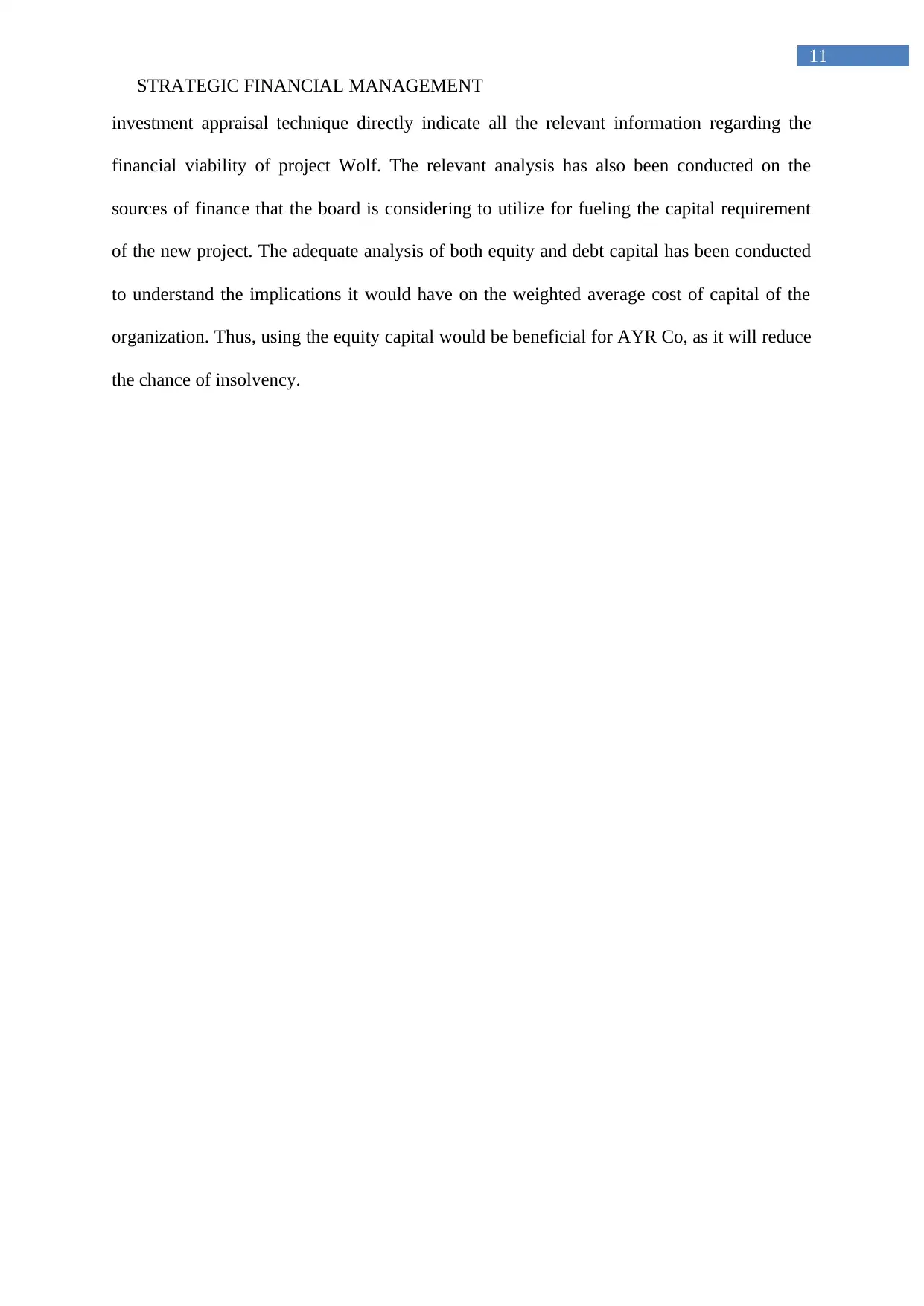
STRATEGIC FINANCIAL MANAGEMENT
11
investment appraisal technique directly indicate all the relevant information regarding the
financial viability of project Wolf. The relevant analysis has also been conducted on the
sources of finance that the board is considering to utilize for fueling the capital requirement
of the new project. The adequate analysis of both equity and debt capital has been conducted
to understand the implications it would have on the weighted average cost of capital of the
organization. Thus, using the equity capital would be beneficial for AYR Co, as it will reduce
the chance of insolvency.
11
investment appraisal technique directly indicate all the relevant information regarding the
financial viability of project Wolf. The relevant analysis has also been conducted on the
sources of finance that the board is considering to utilize for fueling the capital requirement
of the new project. The adequate analysis of both equity and debt capital has been conducted
to understand the implications it would have on the weighted average cost of capital of the
organization. Thus, using the equity capital would be beneficial for AYR Co, as it will reduce
the chance of insolvency.
⊘ This is a preview!⊘
Do you want full access?
Subscribe today to unlock all pages.

Trusted by 1+ million students worldwide
1 out of 17
Related Documents
Your All-in-One AI-Powered Toolkit for Academic Success.
+13062052269
info@desklib.com
Available 24*7 on WhatsApp / Email
![[object Object]](/_next/static/media/star-bottom.7253800d.svg)
Unlock your academic potential
Copyright © 2020–2025 A2Z Services. All Rights Reserved. Developed and managed by ZUCOL.





